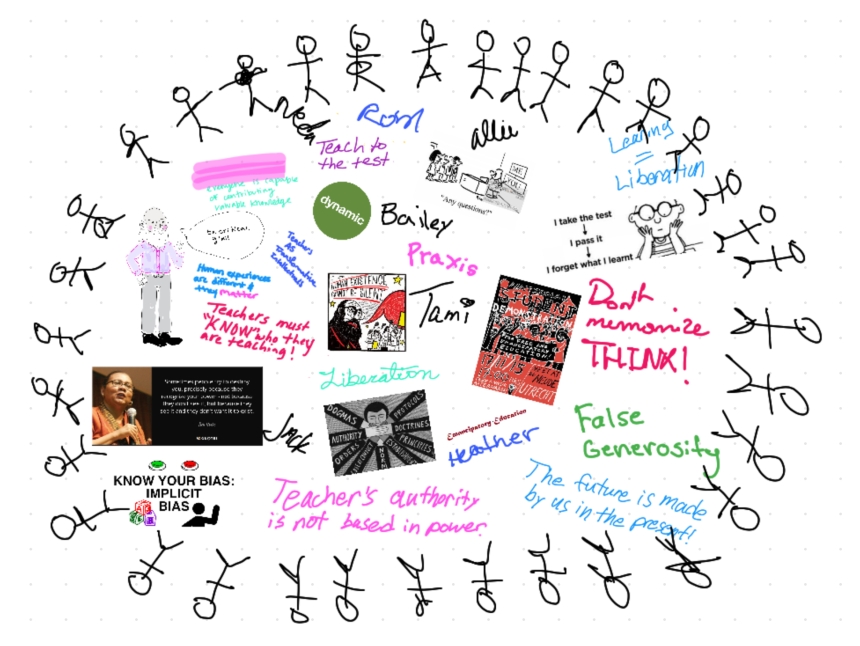Critical Pedagogy in Practice (Not a word cloud)
A blog from Amy, Yan, Shadi, Kadie, Sevda, and Chris, with contributions from Dr. Nelson
I feel it is appropriate to tell the story of this wonderful drawing. As we were discussing what to do for our artifact, we heard the term word cloud thrown around by the other tables. We knew we could make the best word cloud out of any table, but we weren’t that competitive of a table. How it came up, I don’t know, but we learned about why you shouldn’t buy berries when visiting Ukraine. Going down that rabbit hole helped us to realize that anything we do, there can be more to the story as to why. At this juncture we realized our artifact for critical pedagogy was going to be an example that shows how we all can engage with common thing/idea from our respective disciplines. So with that, we settled on this dwelling as a representation of how everyone can engage with an idea or object. Even the picture itself is a reflection on critical pedagogy, as we are only seeing it from the south side. Maybe we need to hear the perspectives of the people on the north side to know that there is a door into the building and a spacious patio for the community to gather on. Below the picture each group member will explain how they were able to engage with this idea from their discipline.

You might be thinking this about our picture.
I’m with Han. It may not look like much, but it’s got it where it counts. Although, it doesn’t do 0.5 past lightspeed nor can it make the Kessel run in under a parsec.
Engineering impact (Amy H): In the renovation of the building and the development of the rooftop garden, it is important to consider the broader impacts of this project. Where is this building located? Why is it being renovated? What are the requirements, constraints, criteria, considerations in such a project? Who has access? Who does not have access? What is the broader impact on the local community?
Horticulture impact (Chris): In the creation of the rooftop garden, needs of the plants need to be considered such as sunlight, temperature, and precipitation. Likewise, if any from of cross pollination is needed, will the location of this garden inhibit that? Could we promote insect pollinators by using certain plant species. We also must consider the need for a rooftop garden in the first place. Is there a reason the residents need to be growing their own produce? Finally, we can say that the use of plants makes the building more aesthetically pleasing. While we can focus on the production value of our plants, there is a value to the greenery that is created.
Landscape Architecture impact (Sevda): To create more equal environment for local community, we renovated a building and installed a rooftop garden on the top of this building. Because there are so many international people in that neighborhood and they have an access problem to their traditional food and also fresh and healthy food. This situation is called as food desert. Since this building is in an urban area and the soil is not suitable for most of the plant which we planted here, we installed rooftop farm even if we have enough garden space around the building. In terms of creating a better support for trees and shrubs, which we planted here, we installed intensive green roof system. To provide equality, whoever needs those plants in this community has a card to enter this rooftop farm. And the product is divided to each person equally. Local community can use this farm as an education opportunity as well. There is a small space in the farm, which people can come and plant themselves and learn how to plant and grow plants, how to maintain them. This application provides an education opportunity to everybody in the community. Instead of teaching sustainability, plants, and ecology, people have an opportunity to observe, have an experience, and learn by themselves. It can be seen as a part of critical pedagogy.
Physics (Shadi): We used solar panel to move one step forward to a sustainable lifestyle. Our sun is a generous source of energy which sends us 1000 W/m2 for free! The solar panels are designed to convert this energy to electricity through photovoltaic effect. Solar cells are made of silicon, which is a semiconductor. They are constructed with a positive layer and a negative layer, which together create an electric field, just like in a battery.
When the light photons from the sun hit the solar cell it makes the electron loose and as a result they start moving due to the electric field provided by our semiconductor. The motion of electron is what we call the electric current.
Entomology Impact (Kadie): We captured the true essence of critical pedagogy and all worked together to create a project that incorporated all of our backgrounds. My background is in entomology. We decided to add a rooftop food garden to our renovated apartment building. This garden will help supply food into the community and is an optimization of space since this building is located in a city. As these plants grow and produce fruit/vegetables, they will become more attractive to insect pests. My background knowledge of working with agricultural pest management will be needed to keep pests away from our food. In addition, we have decided to make our rooftop garden a pollinator-friendly area and plan to include bee boxes. Our rooftop garden will be a model for future renovated structures to follow.









